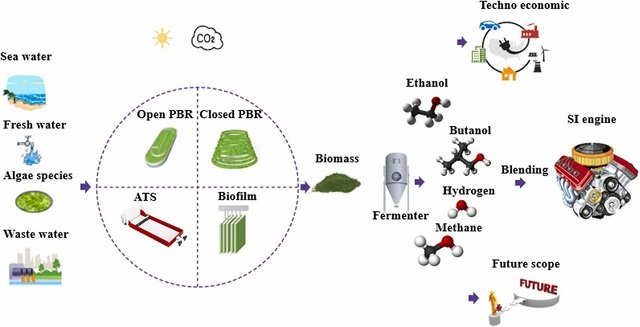
Microalgae have been used as live feed in fish hatcheries, for feed production, biofuel production, soil fertilization, water decontamination, chemical production, and pharmaceutical substances.
However, the cultivation of some microalgae species has faced obstacles when producers want to monitor their microalgae cultures.
Spectral absorption can be used to rapidly, simply, and quite accurately estimate biomass and pigment content in commercially important microalgae and cyanobacteria.
Researcher George N. Hotos from the Plankton Culture Laboratory at the University of Patras developed a new methodology that is easy and cost-effective for microalgae producers to easily and accurately determine the state of their culture.
Hotos cultivated small volumes of the microalgae Dunaliella sp. and the cyanobacteria Anabaena sp. under two intensities of white light (2000 and 8000 lux) and with green, blue, and red light to determine the increase in biomass and pigments.
The researcher examined the absorption spectrum under various lighting scenarios and combined them with their biomass and pigment content records to determine the effect of light quantity and quality on microalgae culture, using an absorption value (Optical Density-OD) of 750 nm.
Absorption spectrum
The absorption spectrum of a microalgae culture sample can provide valuable information about the density of the cultures and the pigments they contain.
In this regard, Hotos evaluated the use of the absorption spectrum as a predictive tool for culture density and photosynthetic pigment content in microalgae cells.
Stay Always Informed
Join our communities to instantly receive the most important news, reports, and analysis from the aquaculture industry.
Predictive capacity
It is widely known that optical density, also known as absorbance or turbidity, of various species of microalgae or other unicellular organisms is used as a quick and non-destructive assessment of biomass because there is a relationship between the amount of light absorbed by suspended cells and their mass or number, depending on the size, shape, and refractive index of particles.
Thus, the mass or number of cells in a suspension can directly affect the amount of light absorbed by the suspension, but the relationship between the number of particles and the optical density to construct a standard curve is difficult.
By using 750 nm values from the series of absorption spectra during each culture’s course, the researcher found a very strong predictive capacity for chlorophyll and carotenoid content using combined data for both low (2000 lux) and high (8000 lux) white light illumination in both microalgae species.
Hotos emphasizes that a prerequisite for the success of the above procedure is the regular recording of the absorption spectrum of each particular culture, to extract and use absorbance values of 750 nm and the peaks of different pigments for correlations.
Light intensity and microalgae performance
According to Hotos, in the study, substantial differences in maximum biomass, pigment content, and pigment ratios were recorded between white light intensities and among the three colors of light used in both microalgae species.
“In both microalgae, maximum biomass was induced by the higher intensity (8000 lux) of white light compared to all other light regimes (2000 lux white or 8000 lux green, blue, and red light),” he reported.
He also highlights that “Both species grew faster and reached higher densities with an 8000 lux light intensity compared to 2000 lux. This was more prominent in Dunaliella, while in Anabaena, the differences were minimal.”
According to the scientists, contrary to biomass increase, whether as growth rate or biomass yield in both species under higher white light intensity, the opposite occurred when examining phycocyanin in Anabaena. “In this case, low light intensity (2000 lux) induced a much higher phycocyanin content compared to high 8000 lux intensity, according to various findings in the literature about cyanobacteria in general.”
Hotos describes that based on the study results and especially for Anabaena cultivation, the prospect of using green light in photobioreactors seems promising to maximize potential, along with increased phycocyanin and carotenoids in cell content.
“In summary, Dunaliella sp. and Anabaena sp. can effectively grow at conditions of 35 ppm salinity, 20°C, and with white light intensities of 2000 – 8000 lux, producing biomass and pigments that can be harvested at the appropriate time using absorption spectra,” Hotos concluded.
Conclusion
“As a result of the calibration dependencies, I have found that it is possible to rapidly, simply, and quite accurately estimate biomass and pigment content in commercially important Dunaliella sp. chlorophyte and Anabaena sp. cyanobacteria using their absorption spectra during the course of their cultivation,” Hotos concludes.
He also reports that biomass production in both species is enhanced by 8000 lux white light compared to 2000 lux, and this also applies to chlorophyll and carotenoids in Dunaliella sp., while 2000 lux enhances phycocyanin production over 8000 lux in Anabaena sp.
“Using colored light, it was discovered that green light enhances phycocyanin in the cyanobacteria Anabaena sp. and carotenoids and chlorophyll in Dunaliella,” he concluded.
The study was funded by the research program “ALGAVISION: Isolation and culture of local phytoplankton species aiming to mass production of antibacterial substances, fatty acids, pigments and antioxidants,” funded by the General Secretariat of Research and Technology of the Greek Government.
Reference (open access)
Hotos, G.N. Quantity and Quality of Light on Growth and Pigment Content of Dunaliella sp. and Anabaena sp. Cultures and the Use of Their Absorption Spectra as a Proxy Method for Assessment. J. Mar. Sci. Eng. 2023, 11, 1673. https://doi.org/10.3390/jmse11091673
Editor at the digital magazine AquaHoy. He holds a degree in Aquaculture Biology from the National University of Santa (UNS) and a Master’s degree in Science and Innovation Management from the Polytechnic University of Valencia, with postgraduate diplomas in Business Innovation and Innovation Management. He possesses extensive experience in the aquaculture and fisheries sector, having led the Fisheries Innovation Unit of the National Program for Innovation in Fisheries and Aquaculture (PNIPA). He has served as a senior consultant in technology watch, an innovation project formulator and advisor, and a lecturer at UNS. He is a member of the Peruvian College of Biologists and was recognized by the World Aquaculture Society (WAS) in 2016 for his contribution to aquaculture.




